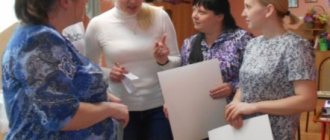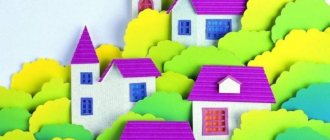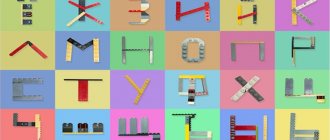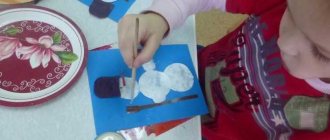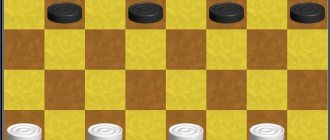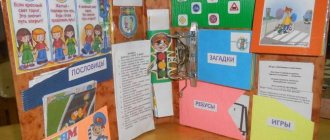Master class for music directors
on the topic: “Development of rhythmic abilities of preschoolers in a playful way”
Goal: Personal contribution to improving the quality of education through the transfer of experience of the practical results of their professional activities to teaching teams.
Tasks:
• To increase the scientific and methodological level of teachers’ competence in the development of musical abilities of preschool children.
• Expand the experience of teachers in the selection of developmental and didactic games, exercises in the formation of rhythmic abilities of preschool children.
• Encourage music directors of preschool institutions to think and practice in introducing modern forms of planning music education in kindergarten.
Progress of the master class
(SLIDE – 1)
Greeting "Find similar"
(gaming, personality-oriented technology)
Goal: Overcoming awkwardness, creating a fun, relaxed atmosphere, cohesion.
Music director:
I want to greet everyone who responded to our invitation and came to the Moscow Region.
And now I will ask those whom I name to stand up to greet you.
- Greetings to the one who is in charge of the family?
— Greetings to those who participate in professional competitions?
- Greetings to the one who came in trousers?
— I salute the one who completes all the documentation on time?
- Greetings to whoever had breakfast today?
— Greetings to someone who is always open to searching and learning new things in their profession?
— Greetings to those who use modern pedagogical technologies in their work?
— I welcome those who are ready to actively work in our master class.
Music director:
(SLIDE – 2)
I would like to begin my speech with the words of K.D. Ushinsky: “To make a serious activity entertaining for a child is the initial task of teaching.” After all, we all know that play is the leading activity for a preschooler. Therefore, in my practice I use gaming techniques. By introducing you to the content of these techniques, I will try to reveal their relevance today...
(SLIDE – 3)
Music director:
(Exercise “Where is the logic”)
And now, to introduce the topic of our master class, I ask you to complete the task: Look at the illustrations and name:
- What do these pictures have in common?
(Answer: Rhythm)
Music director: Yes, today we will talk about rhythm, or more precisely about the development of rhythmic abilities in preschoolers.
(SLIDE – 4)
“Musical-rhythmic abilities are the ability to actively (motorly) experience music, feel the emotional expressiveness of a musical rhythm and accurately reproduce it.” (B.M. Teplov)
(SLIDE – 5)
Rhythmic abilities are formed through the interaction of vision, hearing and movement. It is recommended to develop a sense of rhythm from a very early age and in a form accessible to preschoolers: rhythmic exercises and games. In a playful way, children master the movements of general and fine motor skills, learn to find rhythmic organization in music and speech, and lay out ornamental patterns.
(SLIDE – 6)
Work on developing a sense of rhythm is carried out in the process of children mastering various types of activities in music and physical education classes, in drawing, appliqué, speech development classes, during movement, round dancing, didactic games and dramatization games.
I will show some techniques for conducting musical games that promote the development of rhythmic abilities.
(SLIDE – 7)
Games with singing and musical accompaniment are one of the most interesting and favorite activities for children. With the help of these games, you can not only bring joy and pleasure to kids, but also solve various pedagogical problems in developing rhythmic abilities.
Music director: And now I want to invite everyone to participate in the master class.
(Participants come out, stand scattered, and form a circle.)
Muz.ruk: Everyone came out so well, amicably! Do we need to say hello? Look at me, repeat everything after me!
(Exercise “Hello, palms”)
Goal: development of singing skills, sense of rhythm.
Task: Perform movements in accordance with the text and to the beat of the music.
(Such games are played both accompanied by music and without it. Greetings contribute to the development of speech and coordination of children’s movements, as well as creating a good mood).
Muz.ruk: Also when greeting in a playful way, children’s names can be voiced using sounding gestures:
Ta-nya - two clapping hands (long)
Ta-nech-ka - three blows to the knees (short)
Muz.ruk: Children really like to say hello comically, using different intonations: (children answer the same way).
— We stand in a circle, one in the middle is the leader.
In a “sly” voice: “Hello, little darlings,”
In a “scary” voice: “Hello, kids”…….(Children develop a sense of humor, which in turn develops imagination and intonation expressiveness. Sometimes children come up with their own funny greetings)
Music director: Emile Jacques Delcros said “...Legs are better than other parts of the body in helping to convey to consciousness the sensations of different durations.”
(Exercise “Caterpillar”)
("Big and Little Feet")
Goal: development of musical and rhythmic abilities
(To the music of the 1st part, the “caterpillar” walks with big steps, to the music of the 2nd part, with “stomps” (we turn one after another, hands on the waist of the person in front. We start the movement with the right foot, move our legs slightly to the sides so as not to hit those standing ahead of the children).
(Exercise “Didili, didili” (r.n.p.)
Goal: to teach to feel the emotional expressiveness of a musical rhythm and accurately reproduce it with sounding gestures.
1st group: Didili, didili, where did you see Masha? (They pronounce the text and at the same time tap the rhythmic pattern (downbeat, meter) with wooden sticks.)
2nd group: We looked into the garden - Masha was dancing at the gate.
(They speak, then with “sounding gestures” in this rhythm they depict how Masha dances (claps))
1st group: Didili, didili, where did you see Katya? (Here and below, the 1st group performs the same actions as at the beginning of the nursery rhyme.)
Group 2: We looked into the green garden - Katya was pinching grapes.
(They recite the text, then snap their fingers in this rhythm, showing how Katya plucks grapes.)
1st group: Didili, didili, where did you see Dunya?
2nd group: We looked under the porch - Dunya was gnawing on a cucumber.
(They crunch hard paper in rhythm, imitating the crunch of a cucumber.)
1st group: Didili, didili, have you seen Vanya?
2nd group: In the clearing by the well, Vanya is fighting with a chicken!
(They jostle for each downbeat, pretending to fight with a chicken.)
Our gestures sounded
But it happens
Coordination of movements, rhythm
We develop in exercises.
(Exercise “Our Room”)
Goal: to teach to feel the emotional expressiveness of a musical rhythm and accurately reproduce it with sounding gestures.
Task: Tap a given rhythmic pattern on various objects using sounding gestures.
Our room is a wonderful tool! She knows how to play at any time. Batteries sound like that... Our curtains sound like that... And this too, also music, friends!
(the teacher names some object or object in the hall (chair, window, piano cover, barathea wall, floor, etc. He knocks on it, beating out a simple rhythmic pattern. Children repeat it using sounding gestures (claps, clicks, slaps , stamping, clattering, etc.) There should be no musical instruments in the hall. Attention, memory, and the ability to find objects for sound production are developed)
Such games using gestures of their own body or materials at hand, as well as playing musical instruments, allow children to more deeply feel the pulsation of music and its rhythmic pattern.
(Exercise “Kolobok”)
(“This amazing rhythm” - I. Kaplunova, I. Novoskoltseva)
Goal: formation of auditory attention and rhythmic activity Task:
1) listen to the line, determine the rhythmic pattern using sounding gestures, and model it on the board using cards.
2) in subgroups reproduce: - downbeat - meter - rhythm
Kolobok, Kolobok, Your side is ruddy. You left your grandmother, You left your grandfather
Assignment: you need to listen carefully to the line and lay out the rhythm using circles: large circles - TA, small circles - Tee. Then, we divide into 3 teams. Let's clap:
1st team - downbeat, 2nd team - meter, 3rd team - rhythm
(SLIDE –8)
Games for reproducing rhythmic patterns
(Exercise “Rhythmic Hoops”)
Goal: development of rhythmic and auditory attention Task: Walk through hoops to the music, observing its rhythmic pattern. (The hoops are laid out like a Christmas tree. We stand one after another. You need to walk through the hoops to the music, the steps correspond to the duration of the melody.) Music hand: And now let’s rest a little, We will find the rhythm in the wonderful words.
(Exercise “Solo on palms”) (rhythmic lotto (table)
Goal: development of rhythmic and auditory attention based on visualization. Task: Reproduce the name of the object using sounding gestures and find its place on the map with the corresponding graphic representation of the rhythmic pattern. (Participants sit at tables where large cards with a rhythmic pattern and small cards with pictures are laid out. The names on the small cards are slammed with sounding gestures - ti-ti, TA-TA. You need to fill out the large cards correctly. Check - on the back side there should be a “quartet” "with a yellow circle in the center).
Exercise “Pass the Rhythm”
Goal: Development of rhythmic perception and musical memory. Task: Using sounding gestures, tactilely convey a rhythmic pattern to each other. The exercise is performed while sitting at tables.
Variability: You can use the form - stand one after another in a circle, in a semicircle, put your hands on the shoulders of the person in front. The leader (last in the chain) taps the rhythm on the shoulder of the person behind whom he stands. And he passes the rhythm on to the next one, lightly tapping the rhythmic pattern on the back. The last participant (standing in front of everyone) “conveys” the rhythm by clapping his hands. (By massaging the partner’s back, this game helps to relax and relieve fatigue). You can also change direction by turning 180 degrees.
Logorhythmic exercise
"Tailed, cunning"
Assignment: The poem must be played out using sounding gestures and onomatopoeia.
Hey, tailed, cunning - clap your hands every quarter.
It’s you hanging in the branches - shaking your hands
S-s-s-s-s-s-s-s-s-s-s - put your finger to your lips-
Hey, tailed, cunning - clap your hands every quarter
It's you rustling in the grass - rub your palm against your palm
Sh-sh-sh-sh-sh-sh-sh-sh - put your finger to your lips
Hey, tailed, cunning - clap your hands every quarter
I'm not afraid of yours - "Shu-shu" - wagging your finger
U-ku-shu - make “teeth” from your hands, connect and open your fingertips.
Exercise-dance “Clock”
Goal: development of rhythmic and auditory attention through dance movements.
(Participants take their seats.)
Music supervisor: Much attention must be paid to planning the pedagogical process, as this makes it possible to systematically, consistently solve the problems of raising and teaching preschool children.
(SLIDE –9)
Planning music education in kindergarten.
Planning is an advance determination of the order and sequence of implementation of a program of educational work, indicating the necessary conditions, means used, forms and methods of work.
Music supervisor: In my work I use the following form of long-term and calendar planning.
(SLIDE –10)(SLIDE –11)
(SLIDE –12)
(Exercise “Quickly and Correctly”)
Goal: To encourage teachers to think and practice in introducing modern forms of planning music education in kindergarten. Assignment: Based on the proposed calendar-long-term plan of work for a month in groups of senior preschool age, draw up a lesson summary. (SLIDE –13)
Exercise "Reflection"
Goal: Write a review of the event based on your impressions and professional competence. Task: Put your mark in the cell with the appropriate rating.
Music manager: And at the end of the master class we will smile and give each other a good mood. Now mentally put on your left hand everything that you came to the master class with today: your baggage of thoughts, knowledge, experience. And on the right hand - what we received at the new master class. Let's clap our hands and say THANK YOU at the same time. Thank you for your work and I suggest:
(SLIDE –14)
...To invest a piece of your soul If children sing and dance, Play music or draw, It means the children have become happier. We helped them a little in this. If children laugh, play, and visit the hall with pleasure, it means that we are not working in vain, and our profession is wonderful!
MAGAZINE Preschooler.RF
Master class for music directors of preschool educational institutions “Methods of learning musical-rhythmic movements through play.” Motto: “Dance more joyfully with us as soon as possible!”The purpose of the master class: to improve professional level and exchange experience. Objectives of the master class: • transfer of experience through direct and commented demonstration of the sequence of actions, methods, techniques and forms of pedagogical activity; • joint development of methodological approaches and techniques for solving the problem posed in the master class program; • reflection of their own professional skills by the master class participants; • increasing the level of professional competence of master class participants; • formation of an individual style of creative pedagogical activity of each master class participant. Methods and techniques: Practical, verbal, visual-motor.
Equipment: stereo system, CD with recordings: Playing with Santa Claus “The locomotive is coming, the locomotive is coming,” “Merry Aunt” music. Gladkova, Ivan Kupala “Ay, Zainka”, “Waltz-joke” by Shostakovich, “For me, for you” music by E. Poplyanova, any rhythmic polka.
Musical games, dancing, and exercises are necessary for preschoolers not only for entertainment, but also for their physical, mental and aesthetic development. They help children fall in love with music and respond emotionally to it; develop an ear for music and a sense of rhythm, enrich children with new musical knowledge, and expand their musical horizons.
The material through which musical and rhythmic education is carried out must meet the interests and capabilities of the child and be highly artistic. Instrumental music and round dances should be bright, with a pleasant melody, simple harmony and expressive dynamic shades. The performance of musical works must be accurate and artistic. It is necessary that musical works be accessible when reproduced and transmitted in dance. This allows children to convey the character of the music in the simplest movements, helping them to more deeply perceive and consolidate the content of the work.
The content of this section includes teaching children the ability to move in accordance with the nature of the music, with the means of musical expressiveness, as well as the ability to perform simple elements of dances, formations, exercises, dramatizations, dance in circles, play musical games, both plot and non-plot. classes and in independent activities outside of classes.
The tasks for this section are as follows:
- teach children to coordinate movements with the nature of music, with the most striking means of musical expressiveness: move rhythmically and expressively, play musical games, dance in circles, perform dances;
- develop in children a sense of rhythm, which is expressed in the fact that children feel rhythmic expressiveness in music, respond to it and convey it in movement;
- to develop artistic and creative abilities, which in children of senior preschool age are manifested in a unique individual expression of the game image, inventing, combining dance movements, constructing round dances, and using this knowledge in independent activities.
These tasks are solved by fulfilling the main requirement - the correspondence of the nature of movements to the content and development of the musical image.
When teaching children musical and rhythmic movements, dances, games, and exercises, music directors use various methods:
— visual-auditory (expressive performance of music);
- visual-motor (showing games, dances, individual rhythmic exercises);
- verbal (instructions, explanations during movements);
— exercises: multiple repetitions, varying familiar material; exercises in the ability to perceive and convey an image dictated by a song or music.
If these methods are chosen correctly, they will help the child more deeply and consciously assimilate the content and nature of the work.
The method of teaching musical-rhythmic movements is variable. The development of musical-rhythmic movements at each age stage occurs differently.
At the first stage of work, it is necessary to attract children's attention to music, to lead them to the ability to respond to music with movement. Already at a young age, the child responds emotionally to music, which is expressed in facial expressions and gestures. But his movements are imprecise and sometimes not coordinated with the music. The basis of learning for children of this age is imitation of the actions of an adult. The teacher needs, using personal example and relying on the child’s emotional responsiveness, to develop the ability to listen to music, remember and perform simple movements, small roles, and accurately complete tasks. It is necessary to draw children's attention to the fact that they need to move only when music is playing, teach them to react to changes in contrasting parts, marking them with changes in movements, and stop movements when the music ends.
The teacher's demonstration as a technique is needed at the initial stages of learning a game, dance, or exercise. In the future, the music teacher gives instructions during the performance and corrects the actions of individual children. During the school year, a music teacher teaches children various dance and figurative movements, which are then used in games, dances, and round dances.
Musical education through the use of movement takes on a slightly different character when working with middle school children. In the fourth year of life, children feel the change in contrasting parts of music, they can perform and master small musical tasks, but they are still poorly oriented in space. Therefore, the teacher’s task is to teach how to move in accordance with the brightly contrasting nature of the music, at a slow and fast pace, to respond to the beginning and end of the sound of music, to perform the simplest movements, to convey simple imitation movements of game images (“birds are flying,” “horses are galloping,” “ bunnies are jumping”, etc.).
In the fifth year of life, children already have experience listening to music, they can recognize familiar melodies, determine the nature of the music and individual means of musical expression (dynamics - loud, quiet; registers - high, low; tempo - fast, moderate).
Movements become more rhythmic, clear, consistent with the beginning and end of the music. Children perform more varied movements (straight canter, movement in pairs, single foot stomp, heel kick, etc.) and can move in accordance with the less contrasting nature of the music.
In games, the teacher, with his advice, can help children make their movements more similar to the movements of the characters. For example, in the game “Bear and Hares,” the teacher says: “The bunnies are cheerful, friendly, and jump easily. The bear walks heavily, waddles, his paws are large and heavy. Vova is a great guy, he performs the movements of a bunny very beautifully - easily, to the music, and Vitya is a real bear: he walks heavily, waddles, holds his hands correctly, like the paws of a bear,” etc.
The teacher seems to help the child find the right movement and convey the image correctly to the music. The coincidence of figurative words, music and movement develops the child’s imagination, the child more accurately conveys the character of the game character, movements become free, stiffness disappears, and confidence appears. A very important condition for children of the middle group in performing musical-rhythmic movements is expressiveness and clarity.
However, at this age children still need demonstrations of movements and clear, concise explanations. It is difficult for children to orient themselves in space and some formations, such as formation in columns, circles and others. The sequence of learning games, dances, exercises and the time spent on mastering them vary significantly. Some games and dances are learned by children in one or two lessons, while others require longer time.
Children of the sixth and seventh year of life already voluntarily master the skills of expressive and rhythmic movement. Auditory attention develops, and children’s individual abilities are more clearly demonstrated. They can convey with their movements the varied character of the music, dynamics, tempo, simple rhythmic pattern, change movements in connection with the introduction, with the change of parts of a musical work. Children can master a variety of movements (from rhythmic running with high leg lifts and jumping from foot to foot to polka step, half squat, etc.).
In the older group, the teacher achieves emotional and expressive performance of images by children.
In the preparatory group, children must be conscious of their role and perform movements more efficiently.
In older preschool age, the complication of the requirements of the musical and rhythmic repertoire is aimed at developing in children the ability to feel, experience, distinguish musical images and use means of their expression in movement. The ability to perceive and convey an image, to move expressively in accordance with music is formed in the process of learning games, round dances, dances, and exercises. All this is facilitated by expressive performance, imaginative and accurate display of movements, games, round dances, dramatizations, which give children the opportunity to act creatively.
Children's creative activity gradually develops through targeted learning, expanding musical experience, activating feelings, imagination and thinking.
Thus, in the conditions of interesting, exciting activity—musical and rhythmic—the child’s musical and aesthetic development occurs.
Let us consider specifically the methodology for conducting games, round dances, dances, exercises for children of primary, middle and senior preschool age and teaching methods.
The method of teaching musical-rhythmic movements to three- and four-year-old children is based mainly on the teacher showing children moving well, on emotional and figurative explanations and instructions. In games, the development of the plot is directed by music, determining the changes and nature of movements. The content of story games is dictated by the title and text. For example, the musical game “Vanya Walks.” Learning the game is associated with the disclosure of a musical and poetic image, with a story about its actions. The teacher can first explain to the children how to perform a round dance movement in a circle, then give them the opportunity, listening to the music and the words of the song, to independently portray “Vanya” in their own way. Games “Golden Gate”, “Trap”, game with Santa Claus “The steam locomotive is coming.”
Non-plot musical games most often have certain movements (“Wattage”). In such games, learning includes demonstration and explanation. Other techniques can also be used. First of all, children listen to music to feel its general mood and character. Next, they are explained the construction and form of the work (since the movements change in accordance with the parts, musical sentences, phrases).
In a playful way, various clapping, stamping, swinging, rotating the hands, etc. are learned. Then you can invite the children to figure out how to move to this music, discuss these options (using a children's demonstration) and, in conclusion, show the formation that the kids should learn. This technique helps to master skills in the active perception of music, the development of independent actions, and creative abilities. Dances are learned in the same way as games, but often require additional exercises in mastering and improving dance elements and changes that are unfamiliar to children. The teacher, using different music that corresponds to the movements, exercises the children in these skills.
Some exercises are of an auxiliary nature - aimed at mastering elements of movements that make it difficult for children to dance, dance, and play. We divide all present music directors into 3 age groups: - Younger preschool age (those who have cubes under their chair); - Middle preschool age (those who have rattles under their chair); - Senior preschool age (those who have spoons under their chairs).
Game exercise “Merry Aunt” music. Gladkova.
I have one aunt, this aunt is a merry fellow. When she dances, she does this: Oh, my hands, my hands, my hands are good Oh, my hands, my hands, let’s dance together for the soul!
I have one aunt, this aunt is a merry fellow. When she dances, she does this: Ah, my shoulders, my shoulders, my shoulders are good Ah, my shoulders, my shoulders, let’s dance together for the soul!
I have one aunt, this aunt is a merry fellow. When she dances, she does this: Oh, my sides are my sides, my sides are good Ah, my sides are my sides, let’s dance together for the soul!
I have one aunt, this aunt is a merry fellow. When she dances, she does this: Oh, my legs, my legs, my legs are good Oh, my legs, my legs, let’s dance together for the soul!
I have one aunt, this aunt is a merry fellow. When she dances, she does this: Oh, my ears, my ears, my hands are good Oh, my ears, let’s dance together for the soul!
I have one aunt, this aunt is funny. When she dances, she does this: My jumps, you jumps are good My jumps, let’s dance together for the soul!
In the first part of each verse, you can train children in performing various dance movements. We walk in a circle with a round dance step, a fractional step, hops, a small step on half toes, a side gallop, a step with high legs. To lose, each music director performs movements appropriate to the selected age.
The rabbits will dance to the music of Ivan Kupala “Ay, Zainka.” At the beginning, the bunnies wake up, then they wash themselves, jump to warm up, wiggle their ears, jump in circles, it turns out to be fun. The main thing is to perform all the movements while dancing. You can come up with a variety of movements, I relied on the well-known game - dance bunny.
Relax Exercise “Puppets” music “Waltz Joke” Shostakovich
Music director: Imagine that a thread is tied to each joint. From the beginning, all the threads are taut: the “dolls” stand with straight backs and arms raised high, since threads are also tied to the tips of their fingers. But then I begin to “cut off” the threads coming from the fingers one by one with scissors, and they fall freely. When I “cut” the threads from my elbows, my arms drop freely. Next I “cut off” the strings from the head, back, and knees. Our “puppet” completely relaxed and either squatted down or gently sank to the floor). The puppeteer participants, holding imaginary scissors in their hands, cut off the imaginary threads holding the limbs of the puppet participants. Music director: This exercise teaches children relaxation (relaxation). And lying on the floor during class is a great pleasure for the baby
Game exercise “Gnomes” (polka music) Children-gnomes go to the forest with empty baskets, return from the forest with berries (step 1/8, fractional step, retops) and with mushrooms (step ¼, heavy step).
Dance-game for kids “For me, for you”, music by E. Poplyanova.
1. I, you have Beautiful hands, (palms up and down) I, you have Beautiful legs. (putting your feet on your heels)
CHORUS: With our hands we clap, clap, clap, clap. You and I with our feet Top, top, top, top.
2. I, you have a Nose, like a button, (movement “bib”) I, you have a Mouth, like a cranberry. (kiss) CHORUS.
3. I, you (with a finger on the eyebrows) Beautiful eyebrows. I, you (pat yourself or a friend on the head) have a smart head. CHORUS.
4. I, you have cheeks like apples, I, you, have dimples on my cheeks. CHORUS.
5. I, you have ringing palms, I, you have legs like springs CHORUS: You and I have hands Slap, slap, slap, slap. (on the knees) You and I, with our legs, jump-jump, jump-jump!
| Next > |

